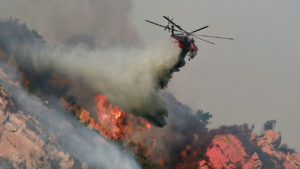It is the middle of fall and California continues to get overwhelmed by wildfires. In November alone there has already been four confirmed wildfires that have consumed at least 1,000 acres of land and three of which that are yet to be contained. These fires alone have already accounted for the loss of at least 100 people, 10,000 homes and hundreds of architectural landmarks throughout the Golden State.
Honey Run Covered Bridge
The Camp Fire in Butte County is already the deadliest wildfire in California’s history with more than 200 people still missing. In addition to burning the entire city of Paradise to the ground the historic Honey Run Covered Bridge also fell victim to the 150,000 acre fire. The 132 year old three-span truss bridge listed on the National Register of Historic Places (NHRP) was the only one in the United States.
The monumental bridge from the gold rush era connected Butte Creek Canyon to Paradise Ridge over Butte Creek. Spanning 238 ft the bridge was built in response to the discovery of gold in Butte County. The covered bridge supported vehicular traffic until 1965 when damage from a traffic accident made it unusable. The Honey Run Covered Bridge Association was formed and restored the bridge to allow for pedestrian traffic and preserve its historic value. It is unclear if there are any plans to restore the bridge following this disaster.
“We don’t know what to do yet, but we’ll go on, like people do,” he said. “We’ll be like phoenixes rising out of the ashes. We gotta keep living.” Said Robert Catalano, president of the Honey Run Covered Bridge Association.
Peter Strauss Ranch
The Woolsey Fire in the Los Angeles area has made its way through Calabasas, Agoura Hills and Malibu taking out a number of mansions owned by celebrities along with other historic Hollywood sites. As the wildfire rolled through the Santa Monica Mountains it made its way to the iconic Peter Strauss Ranch and only left behind some stone walls and a chimney.
The National Park Service operated ranch was named after the Emmy Award-winning actor Peter Strauss since he was the last private owner. The distinctive home was the venue for many concerts in the 50’s featuring Johnny Cash and Willie Nelson. The stone ranch was built in 1926 and remained a popular place for social events, weddings, art exhibits and outdoor concerts until it was flattened by the Woolsey Fire on November 14, 2018.

M*A*S*H TV Set
Over 80 percent of the National Park Service areas in the Santa Monica Mountains have burned from the Woolsey Fire which leaves the potential for a lot of architectural loss. One being the set for the popular TV show M*A*S*H. Ironically the original set burned down during the last episode of the show but was later restored in 2007. That restored set is now destroyed along with the rich cinema history for Malibu State Park.
“People don’t realize they’ve been watching movies all of their lives that took place here,” Tim Johnston, a retired firefighter explains. “Their mom’s been watching all her life. Even their grandma has been watching all her life.”
Paramount Ranch
The Woolsey Fire has already burned over 100,000 acres of land in the Santa Monica mountains.Starting in Simi Valley the wildfire quickly made its way towards the Paramount Ranch located in Agoura Hills. The National Park managed the land that was used as a set for many Western Town movies and TV shows including the HBO series Westworld.
This location has been a popular filming location since 1927 when Paramount pictures purchased the 2.700 acre land. The aftermath of the fire left only the old western-style church standing but Paramount officials are confident that someday the TV set will once again be operational.
While both the Woolsey Fire and Camp Fire continue to burn it is still unknown how many more architectural landmarks will be affected. The Woolsey Fire will definitely have more architectural loss due to its proximity to extremely popular filming locations and celebrity homes.
Randy Haberkamp of Motion Picture Arts and Sciences delivers his thoughts about how the history that has been destroyed from the wildfires. “This land was essential to why the film industry was able to move here in the first place because you could create so many things with so many different environments,” he says, “It’s an environment that could be made to look like any place, even though a discerning viewer might see the same mountain in the back in lots of different movies.”
